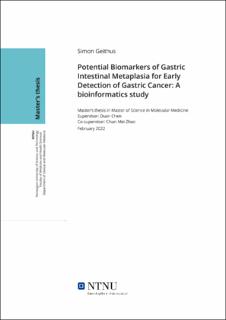| dc.description.abstract | Gastrisk tarmmetaplasi er ein irreversibel tilstand som innehar ein auka kreftrisiko. Utviklinga av gastrisk tarmmetaplasi går generelt uhindra føre seg grunna mangelen på kliniske symptom. Der er foreløpig ingen behandling for gastrisk tarmmetaplasi, forutan overvaking før den utviklar seg til dysplasi eller kreft. Målet med denne avhandlinga var å finne biomarkørar for gastrisk tarmmetaplasi for tidleg oppdagelse av magekreft ved bruk av bioinformatiske metodar.
Det bioinformatiske datasettet som blei brukt inkluderte mikroarraydata frå 16 pasientar gjennomgått kirurgiske biopsiar med både gastrisk tarmmetaplasi og magekreft i kvar pasient (ved St. Olavs Hospital) og enkeltcelle RNA data frå 13 pasientar etter endoskopisk biopsiar med ”wild” overfladisk gastritt (3 pasientar), kronisk atropisk gastritt (3 pasientar), gastrisk tarmmetaplasi (6 pasientar) og tidleg magekreft (1 pasient)(ved NCBI GEO under tilgangsnummer GSE134520). Dei bioinformatiske metodane brukt var normalisering med husholdningsgen, DESeq2 og Limma, data visualisering med R, differensial likning og ingenuity pathway analysis.
Resultatet viser at potensielle biomarkørar for gastrisk tarmmetaplasi inneber signaliseringsvegane: xenobiotisk metabolisme CAR signalveg, xenobiotisk metabolisme PXR signalveg og sukrosenedbrytning V; transkripsjonsfaktorane HNF1A, HNF4A, CDX2, PPARGGC1A og GATA4; endogene kjemikaliane elaidinsyre og d-glukose; og vekstfaktoren EGF.
Konklusivt viser avhandlinga at metoden og dei bioinformatiske markørane kan vere nyttige for tideleg funn av magekreft. | |
| dc.description.abstract | Gastric intestinal metaplasia (GIM) is an irreversible condition that carries an increased cancer risk. The development of GIM is generally unhindered due to a lack of clinical symptoms. Currently, there is no treatment for GIM, except for surveillance before GIM advances into dysplasia or cancer. The aim of this thesis was to discover biomarkers of GIM for early detection of gastric cancer by the means of bioinformatics.
The bioinformatic dataset used in this thesis included microarray data of 16 patients from whom surgical biopsies exhibited both GIM and gastric carcinoma in each patient (at St. Olavs Hospital) and single-cell RNA data of 13 patients from whom endoscopic biopsies showed wild superficial gastritis (3 patients), chronic atrophic gastritis (3 patients), GIM (6 patients), and early gastric carcinoma (1 patient)(at NCBI GEO under accession number GSE134520). The bioinformatic methods applied in this thesis included normalization with housekeeping genes, DESeq2, and Limma, data visualization with R, differential equations, and ingenuity pathway analysis.
The result showed that potential biomarkers of GIM encompassed signaling pathways (i.e., xenobiotic metabolism CAR signaling pathway, xenobiotic metabolism PXR signaling pathway, and sucrose degradation V), transcription factors (HNF1A, HNF4A, CDX2, PPARGGC1A, and GATA4) endogenous chemicals (elaidic acid and d-glucose), and the growth factor EGF.
In conclusion, the methodology applied in this thesis and the bioinformatic biomarkers of GIM found in this thesis may be useful for early detection of gastric cancer. | |
